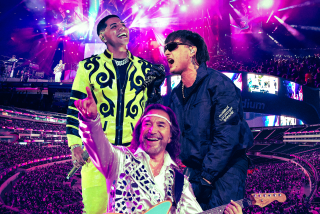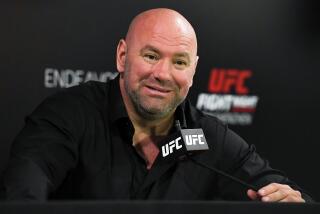There’s More Fight Left in L.A.
- Share via
An event occurred Saturday that is almost certain to have a significant impact on the future of boxing in Los Angeles.
Oscar De La Hoya, literally wearing his promoter’s cap (black with a gold corporate logo), stepped to the microphone inside an Olvera Street restaurant at approximately 1 p.m. and announced that featherweight champion Marco Antonio Barrera has signed with Golden Boy Promotions for his next fight.
If both parties are satisfied with the relationship, the deal probably will be extended, which, De La Hoya said, could be significant for Los Angeles. Barrera, who is from Mexico City, has fought most of his important bouts, including both classics against Mexican rival Erik Morales, in Las Vegas.
But De La Hoya believes Barrera could broaden his appeal by fighting in L.A. Discussions have already begun about bringing Barrera-Morales III to Staples Center. The arena has Oct. 4 blocked out for it, although Barrera said he would rather the fight occur next spring.
That would enable him to fight a couple of tuneups, one of which might be held at the Grand Olympic Auditorium.
“Little by little, Los Angeles is becoming the boxing capital of the world,” De La Hoya said.
Someone asked if he would attend Saturday’s heavyweight title fight at Staples Center.
“No,” De La Hoya said. “Too expensive.”
*
Not necessarily.
An announced crowd of 15,939 was inside the 18,000-seat arena to see Lennox Lewis defend his title in a sixth-round technical knockout of Vitali Klitschko, but we won’t know until later how many people bought tickets.
Educated guesses were that between 10,000 and 11,000 people paid face value and that everyone else either paid less or scored free tickets.
Regardless of how much anyone paid, the price turned out to be right. Tim Leiweke, Staples Center president, said last week that the first fight inside the arena, De La Hoya vs. Shane Mosley, was “one of the best things we’ve ever done in this building.” He said Saturday night that Lewis-Klitschko ranked right alongside it.
Of course, that’s what he was saying after the fight.
Two weeks before, he couldn’t extricate himself from it fast enough. It was hard to blame him. He offered a substantial site fee for a card with both Lewis and Mike Tyson on it, albeit not in the same fight, then still agreed to pay a more-than-fair price for Lewis vs. Kirk Johnson after Tyson bailed.
But, after Johnson was injured and replaced by Klitschko, Leiweke, although acknowledging that a better fight had been created, began thinking that maybe the card was cursed and took his money off the table. He gave the promoter the keys to the building and wished him luck.
That didn’t thrill the promoter, a New Jersey guy named Gary Shaw who prefers business partners with stronger constitutions. His mood wasn’t improved by reports last week of mediocre ticket sales.
“If Lennox Lewis-Klitschko for the heavyweight title can’t sell out, then L.A. is not a major fight town,” he said. “This fight would have sold out at Madison Square Garden. It would have sold out Vegas. It would have sold out Atlantic City.”
Shaw had been told by virtually everyone west of Trenton that he could have his sellout if he signed a creditable Latino fighter for the undercard. There were even reports that rival promoter Bob Arum had offered him the Marquez brothers from Mexico City.
“I’ve got nothing against Laila Ali or Lucia Rijker,” De La Hoya said, referring to two fighters on the undercard. “They’re great fighters. But they’re not attractive for the real fans here in L.A.”
By the end of the week, Shaw conceded.
“Los Angeles is a great fight town, but it’s Hispanic oriented,” he said. “For everything else, the jury is out.”
*
Ticket sales might have been disappointing, but the exuberance of the fans, the electricity inside the building, during Saturday night’s fight was a revelation to Shaw, Leiweke and anyone who thought he knew all about blase L.A.
For one night, the city was the boxing capital of the world.
Lewis received by far the larger ovation at the outset, but, by the end of the third round, most of the fans were solidly behind the bloodied but unbowed Klitschko, the transplanted Angeleno from Ukraine.
“He’s Rocky!” said HBO executive Mark Taffet, no doubt aware that Sylvester Stallone was in the building.
“What a buzz,” Leiweke said. “There’s nothing like heavyweights. This is great for L.A.
“If they have the rematch here, they’ll sell it out,” he added. Asked if he would pull his checkbook out of his pocket and bid against the Las Vegas casinos for the fight, he responded, “We’ll step up to the plate.”
Shaw, who learned a long time ago in boxing that your enemy one day is bound to be your partner the next, said he’d be glad to bring the rematch to Staples Center for the right deal.
“Staples didn’t know what they had in this fight, but now they do,” he said.
In Klitschko, Los Angeles also has a new boxing hero to go along with De La Hoya, Mosley and Fernando Vargas. There’s room for all of them here, Barrera too. Maybe that’s what Klitschko was saying when he entered the ring Saturday night to the Eagles’ “Hotel California.”
*
Randy Harvey can be reached at randy.harvey@latimes.com.
More to Read
Go beyond the scoreboard
Get the latest on L.A.'s teams in the daily Sports Report newsletter.
You may occasionally receive promotional content from the Los Angeles Times.










